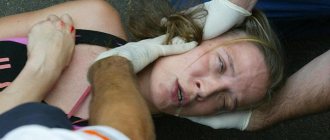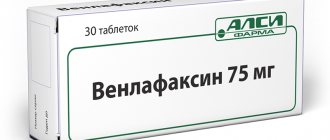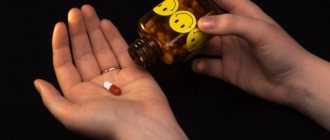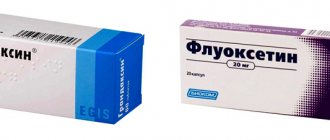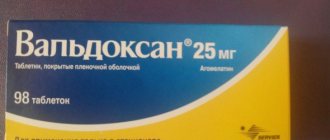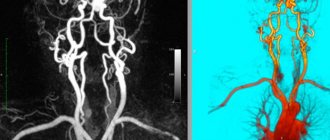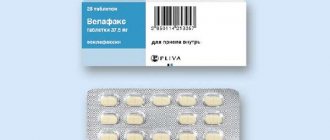Antidepressant: Venlafaxine Manufacturer: ALSI Pharma JSC (Russia) Active ingredient: Venlafaxine
Venlafaxine is an antidepressant. Moreover, in terms of its chemical composition, the drug does not belong to any type of antidepressant. After using the medication, there is an increase in the activity of neurotransmitters during the propagation of impulses in the central nervous system. The main purpose of the medication is to treat depression and related conditions.
The drug interacts specifically with a number of drugs, which must be taken into account when prescribing it. Venlafaxine is characterized by side effects affecting the cardiovascular and central nervous systems. The drug has varied reviews from patients and doctors. More often, side effects from taking the medication are emphasized, as well as the presence of a strong withdrawal syndrome.
Instructions for use of Venlafaxine
The drug belongs to the group of antidepressants - drugs that can eliminate feelings of anxiety, fear, hopelessness and other deviations from the norm of psychological stability. The effect of using Venlafaxine is obvious, the drug has received many positive reviews from patients, but you cannot take tablets and set the dosage yourself. The instructions for use of Venlafaxine state that the medication is available only with a prescription.
Composition and release form
- The medicine (trade name Venlafaxine, Venlafaxine Retard) is available in 2 forms:
- Pills. Oblong (flat-cylindrical), covered with a film shell of white or slightly marbled color. On one side of the tablet surface there is a separating line in the center.
- Capsules. Covered with a red or light pink shell.
The drug is available in cardboard packages, each containing from 1 to 5 blisters, containing 10 tablets (capsules) in 1 blister.
| Release form | Active ingredient, mg per 1 tablet | Excipients |
| Pills | venlafaxine hydrochloride – 37.5 or 75 |
|
| Capsules | venlafaxine hydrochloride – 150 |
Pharmacodynamics and pharmacokinetics
The drug Venlafaxine belongs to a group of medications that are indicated to relieve depression. The drug has a unique chemical composition, which differs significantly from other groups of antidepressants. It is a racemic combination of two stereoisomers, which are mirror images.
Once inside the body, the active component of the drug activates the production of neurotransmitters in the central nervous system - substances that are responsible for the ability to positively perceive the environment and react less to stimuli . Depending on the amount of the active substance, Benlafaxine and its main metabolite affect the reuptake of serotonin (when taking 125 mg of the drug), norepinephrine (at a dose of 225 mg) and dopamine (daily dose - 375 mg).
Venlafaxine does not have an immediate effect on the mental state or nervous system; it acts gradually and has a cumulative effect. To achieve positive results, drug therapy must be long-term. The medicine is well absorbed when taken orally. After the first use, maximum absorption is achieved after 2-4 hours, and absorption of the metabolite - after 3-4 hours. If you take the medicine repeatedly, equilibrium absorption is achieved after 3 days.
Indications for use
The drug Venlafaxine is prescribed for the following disorders:
- depression;
- anxiety disorders, neurosis;
- treatment of diabetic polyneuropathy;
- panic attacks;
- social phobias;
- as an adjuvant for the complex treatment of migraine;
- prevention of relapse of depressive disorder.
How does the drug work?
Velaxin is a new generation antidepressant. According to the chemical structure, its active substance does not belong to any known class of antidepressants (for example, tricyclic, tetracyclic or others). Experts say that this drug is a racemate of 2 active enantiomers.
The principle of action of this medication is associated with its ability to potentiate the transmission of nerve impulses in the central nervous system.
According to the instructions, venlafaxine, as well as its main metabolite (ODV or O-desmethylvenlafaxine) are powerful norepinephrine and serotonin reuptake inhibitors and weak dopamine reuptake inhibitors. It should also be said that these substances can reduce beta-adrenergic activity after a single dose and with continuous use of the medication. EDV and venlafaxine are equally effective at inhibiting neurotransmitter reuptake.
What else is notable about the drug “Velaxin”? The instructions indicate that the active component of this medicine has an affinity for n- and m-cholinergic receptors, α1-adrenergic receptors of the brain and histamine H1 receptors. In addition, it inhibits the effect of MAO and is not similar to phencyclidine, opioid, benzodiazepine and NMDA receptors.
Directions for use and dosage
The dosage and frequency of taking the medicine is determined exclusively by a medical specialist. When prescribing, the doctor must examine the patient’s medical history and assess the mental state. The medication is taken orally, at the same time of day, simultaneously with meals. The drug should be taken with a small amount of liquid. Chewing the tablets, dividing them into several doses, or dissolving them in water is prohibited. The duration of therapy ranges from 6 to 12 months. The doctor may increase the dose gradually.
The drug dosage regimen is as follows:
- The initial dose for adult (18-59 years old) patients is 75 mg, divided into 2 doses per day (37.5 mg each). If Venlafaxine is well tolerated, after 2 weeks of therapy the daily dose can be increased to 150 mg or 225 mg. If clinically necessary, due to the complication of symptoms, the dosage can be increased in a shorter period of time (after 4 days of treatment). The maximum daily dose of the drug (375 mg) is prescribed only under inpatient observation conditions. After the clinical picture improves, the daily amount of medication taken is reduced.
- In order to prevent relapses, the doctor prescribes minimum daily doses (37.5 mg) of the drug.
- For mild renal or liver failure, the dosage of the drug is 75 mg per day, for moderate - the dose is reduced by 25-50%.
- Elderly people are prescribed the lowest effective dose, provided that the patient does not have any chronic or acute illnesses. An increase in the norm is possible after a thorough medical examination and constant observation by a doctor in a hospital setting.
- For depression. The standard daily dose is 75 mg (single dose), for severe depression - 150 mg once a day.
- Anxiety disorders and phobias - daily dose of 75 mg once, if after 2 weeks the condition improves, the dose is increased to 150 mg daily.
- Relapse prevention. The medicine is effective during long-term treatment: for social phobia - up to 12 months, anxiety disorders - up to 6 months, acute episodes of depression - from 6 months. The dosage of the drug for prevention is similar to the doses that are prescribed to patients for the treatment of a specific emotional illness. Regular monitoring of the effectiveness of long-term drug therapy is necessary; the patient should be examined every 2-3 months.
- Switching from tablets to capsules. Patients suffering from depression can, after short-term therapy with tablets, switch to taking extended-release capsules with dose adjustment.
A single dose of tablets does not provide a therapeutic effect, and abrupt withdrawal of treatment can further aggravate the situation - worsen the patient’s mental state, leading to suicidal tendencies. It is recommended to stop taking the drug by gradually reducing the dose. The duration of the dosage reduction period depends on the dose of the drug, the duration of treatment, the individual characteristics and susceptibility of the patient. With a course of therapy of 6 weeks or more, the period of withdrawal from tablets is at least 14 days.
Notes
- Comparative efficacy and acceptability of 12 new-generation antidepressants: a multiple-treatments meta-analysis: The Lancet
- Combination of Antidepressant Medications From Treatment Initiation for Major Depressive Disorder: A Double-Blind Randomized Study (inaccessible link)
- Angell M.
The Epidemic of Mental Illness: Why?. The New York Review of Books (June 23, 2011). Archived from the original on September 21, 2012. - Kirsch I, Deacon BJ, Huedo-Medina TB, Scoboria A, Moore TJ, Johnson BT (February 2008). "Initial Severity and Antidepressant Benefits: A Meta-Analysis of Data Submitted to the Food and Drug Administration." PLoS Medicine 5
(2):e45. DOI:10.1371/journal.pmed.0050045. PMID 18303940. - Venlafaxine (Velaxin): results of international studies of a third generation antidepressant (inaccessible link)
- ↑ 1 2 3 Bazhin A.A.
Handbook of psychopharmacology. - St. Petersburg: SpetsLit, 2009. - 64 p. — 1000 copies. — ISBN 978-5-299-00399-4. - Pacchiarotti I, Bond DJ, Baldessarini RJ, Nolen WA, Grunze H, Licht RW, Post RM, Berk M, Goodwin GM, Sachs GS, Tondo L, Findling RL, Youngstrom EA, Tohen M, Undurraga J, González-Pinto A, Goldberg JF, Yildiz A, Altshuler LL, Calabrese JR, Mitchell PB, Thase ME, Koukopoulos A, Colom F, Frye MA, Malhi GS, Fountoulakis KN, Vázquez G, Perlis RH, Ketter TA, Cassidy F, Akiskal H, Azorin JM , Valentí M, Mazzei DH, Lafer B, Kato T, Mazzarini L, Martínez-Aran A, Parker G, Souery D, Ozerdem A, McElroy SL, Girardi P, Bauer M, Yatham LN, Zarate CA, Nierenberg AA, Birmaher B , Kanba S, El-Mallakh RS, Serretti A, Rihmer Z, Young AH, Kotzalidis GD, MacQueen GM, Bowden CL, Ghaemi SN, Lopez-Jaramillo C, Rybakowski J, Ha K, Perugi G, Kasper S, Amsterdam JD, Hirschfeld RM, Kapczinski F, Vieta E (November 2013). "The International Society for Bipolar Disorders (ISBD) task force report on antidepressant use in bipolar disorders." The American Journal of Psychiatry 170
(1): 1249–62. DOI:10.1176/appi.ajp.2013.13020185. PMID 24030475. - ↑ 1 2 3 Ushkalova A.V., Ushkalova E.A., Shifman E.M., Mosolov S.N.
Pharmacotherapy of mental disorders during pregnancy // Biological methods of treatment of mental disorders (evidence-based medicine - clinical practice) / Ed. S.N. Mosolova. - Moscow: Publishing House "Social and Political Thought", 2012. - P. 913-980. — 1080 s. — 1000 copies. — ISBN 978-5-91579-075-8. - Pharmacotherapy in neurology and psychiatry: [Trans. from English] / Ed. S. D. Enna and J. T. Coyle. - Moscow: LLC: "Medical Information Agency", 2007. - 800 pp.: ill. With. — 4000 copies. — ISBN 5-89481-501-0.
- ↑ 1 2 3 4 5 6 7 8 9 Minutko V.L.
Depression. - Moscow: GEOTAR-Media, 2006. - 320 p. — 2000 copies. — ISBN 5-9704-0205-2. - ↑ 1 2 3 4 5 6 7 8 9 10 11 Podkorytov V. S., Chaika Yu. Yu.
Depressions. Modern therapy. - Kharkov: Tornado, 2003. - 352 p. — ISBN 966-635-495-0. - ↑ 1 2 3 4 5 6 7 8 9 10 Shchekina E. G.
Side effects of modern antidepressants // Pharmacist. - 2007. - Issue. 23. - ↑ 1 2 3 4 5 6 Bykov Yu. V., Bekker R. A., Reznikov M. K.
Resistant depression. Practical guide. - Kyiv: Medkniga, 2013. - 400 p. — ISBN 978-966-1597-14-2. - Montejo AL, Llorca G., Izquierdo JA, Rico-Villademoros F.
Incidence of sexual dysfunction associated with antidepressant agents: a prospective multicenter study of 1022 outpatients. Spanish Working Group for the Study of Psychotropic-Related Sexual Dysfunction. (English) // The Journal of clinical psychiatry. - 2001. - Vol. 62 Suppl 3. - P. 10-21. - PMID 11229449. [correct] - ↑ 1 2 Evans EA, Sullivan MA.
Abuse and misuse of antidepressants // Subst Abuse Rehabil. — 2014 Aug 14. — Vol. 5. - P. 107-20. — DOI:10.2147/SAR.S37917. - PMID 25187753. - Volkov V.P.
Iatrogenic psychoneurosomatic syndromes. - Tver: Triad, 2014. - 320 p. - Clinical psychiatry: [Text. manual]: Transl. from English, revised and additional / H.I. Kaplan, B.J. Zadok; Ed. and ed. add. Yu.A. Alexandrovsky, A.S. Avedisova, L.M. Bardenstein et al.; Ch. ed.: T.B. Dmitrieva. - Moscow: GEOTAR MEDICINE, 1998. - 505 p. — ISBN 5-88816-010-5. Original:
Pocket Handbook of Clinical Psychiatry / Harold I Kaplan, Benjamin J Sadock. - Baltimore: Williams & Wilkins. — ISBN 0-683-04583-0. - Rational pharmacotherapy in psychiatric practice: a guide for practitioners / Ed. ed. Yu. A. Alexandrovsky, N. G. Neznanov. - Moscow: Litterra, 2014. - 1080 p. — (Rational pharmacotherapy). — ISBN 978-5-4235-0134-1.
- Fava GA Benasi G. Lucente M. Offidani E. Cosci F. Guidi J.
Withdrawal Symptoms after Serotonin-Noradrenaline Reuptake Inhibitor Discontinuation: Systematic Review // Psychotherapy and Psychosomatics. — 2020. - Janiczak F. J., Davis J. M., Preskorn S. H., Eid F. J. Jr.
Principles and practice of psychopharmacotherapy. - 3rd. - M., 1999. - 728 p. — ISBN 966-521-031-9. (unavailable link) - Buckley NA, McManus PR
Fatal toxicity of serotoninergic and other antidepressant drugs: analysis of United Kingdom mortality data. (English) // BMJ (Clinical research ed.). - 2002. - Vol. 325, no. 7376. - P. 1332-1333. - PMID 12468481. [fix]
Drug interactions
Concomitant use of Venlafaxine with MAO inhibitors (Voriconazole, Saquinavir, Ritonavir, Ketoconazole, Atazanavir) is contraindicated. Venlafaxine treatment is recommended 14 days after inhibitor therapy . When taken together or without a break between these two medications, side effects may occur in the form of nausea, sweating, vomiting, fever, and seizures.
Particular caution should be observed when combining Veltafaxine with drugs that affect the central nervous system, since the experience of using Venlafaxine in these conditions has been little studied:
- Lithium, Clozapine, Metoprolol. Complex use increases the concentration of the latter listed drugs in the blood, which is fraught with adverse effects;
- Ritonavir, Clarithromycin, Ketoconazole, Itraconazole - the concentration of Venlafaxine in the blood plasma increases;
- Imipramine, Diazepam, Risperidone - the pharmacokinetics of the drugs and their metabolites do not change;
- Haloperidol. Its effect may intensify;
- Preparations containing ethanol. Psychomotor activity is suppressed.
In addition, the drug should not be combined with the following medications or procedures:
- Conducting electroconvulsive therapy. Epileptic seizures may occur.
- Medicines that affect serotonin transmission (Tramadol, Sumatriptan, Sibutramine) - there is a risk of prolonged seizures and serotonin syndrome.
- Drugs that affect platelet function and blood clotting (acetylsalicylic acid, non-steroidal anti-inflammatory drugs, Warfarin) increase the likelihood of bleeding.
Complex treatment with Venlafaxine with:
- Antihypertensive and antidiabetic drugs.
- Cimedin. Suppresses the metabolism of Venlafaxine, but does not significantly affect its conversion to EDV.
Under no circumstances should you drink alcoholic beverages during the course of taking the medication.
Side effects
Significant negative effects are rare; more often the drug is well tolerated. If the instructions for use are not followed, the following negative consequences may occur:
- General state. Chronic fatigue, weakness, Quincke's edema, chills, anaphylactic manifestations.
- From the side of the central nervous system. Frequent headaches, tremors, unusual dreams, hypertonicity, dizziness, dry work, sleep disturbance, decreased libido, stupor, muscle spasms, paresthesia, sometimes apathy, imbalance, hallucinations, epileptic seizures, psychomotor agitation, aggression, delirium, suicidal thoughts.
- From the gastrointestinal tract. Vomiting, nausea, constipation, anorexia, in rare cases - hepatitis, pancreatitis.
- Respiratory system. Bronchitis, yawning, chest pain, shortness of breath.
- The cardiovascular system. Arterial hypertension, ventricular tachycardia, hypotension, fainting, ventricular fibrillation.
- Blood supply system. Ecchymosis (bleeding into the skin), thrombocytopenia, gastrointestinal bleeding, neutropenia.
- Metabolism. Loss of body weight, hyponatremia, increased cholesterol levels.
- Genitourinary system. Anorgasmia, ejaculation disorders, impotence, difficulty urinating, menstrual irregularities, urinary incontinence.
- Sense organs. Violation of accommodation, pupil focusing, taste sensations, dry eyes, noise or ringing in the ears.
- Skin covering. Sweating, rash, erythema, urticaria, itching.
- Musculoskeletal system. Rhabdomyolysis.
When changing the dose of the drug or abruptly stopping its use, symptoms of withdrawal syndrome may occur:
- sleep disorders (insomnia, drowsiness, difficulty falling asleep, interrupted sleep, unusual dreams);
- anxiety;
- confusion;
- increased sweating;
- dry mouth;
- paresthesia;
- diarrhea;
- vomit;
- decreased appetite;
- increased nervous excitability.
Withdrawal syndrome
If you stop taking the drug abruptly, the following symptoms may occur:
- increased fatigue;
- state of increased drowsiness;
- the occurrence of dizziness;
- nausea;
- state of anorexia;
- increased dryness in the mouth;
- state of insomnia;
- increased anxiety;
- increased irritability;
- state of hypomania.
Article on the topic: Complications of adenovirus infection - a list of possible pathologies
To avoid the manifestation of all these symptoms, the dosage of Venlafaxine should be reduced gradually.
Overdose
When the daily dose of Venlafaxine increases, an overdose may occur, which is manifested by the following symptoms:
- convulsive state;
- disturbance of consciousness (drowsiness, coma);
- too low or high blood pressure;
- agitation (strong emotional arousal);
- bradycardia;
- diarrhea,
- dizziness;
- gagging;
- mydriasis (pupil dilation);
- tachycardia.
An overdose of the drug in combination with other psychotropic medications or alcohol is very dangerous and there is a high probability of death. Venlafaxine does not have antidotes, so it is necessary to urgently call doctors and take the following actions:
- rinse the stomach without vomiting - take sorbent (activated carbon). If there is no risk of aspiration of vomit, drink more than a liter of salt water, a weak solution of potassium permanganate or baking soda.
- Before doctors arrive, monitor the functioning of the vital functions of the body (breathing, heart rate, blood circulation).
Contraindications
The medicine is not recommended for use:
- with severe problems with the kidneys or liver;
- pregnant women and breastfeeding mothers (the active substance and its metabolite bind to proteins in the blood and can therefore pass into milk);
- children under 18 years of age;
- in case of hypersensitivity to the components of the drug.
Venlafaxine should be taken with caution when:
- simultaneous treatment with diuretics, weight loss drugs;
- hyponatremia;
- manic state;
- arterial hypertension;
- suicidal thoughts;
- predisposition to bleeding from the mucous membrane or skin;
- unstable angina;
- simultaneous administration of MAO inhibitors;
- recent myocardial infarction;
- closed glaucoma;
- arrhythmias.
Efficiency
In 2009-2010, American scientists identified antidepressants that were superior in their effects to other drugs. This group also included venlafaxine.
The fact was revealed that among 105 patients who were treated with a combination of
venlafaxine
And
mirtazapine
, exacerbation of depression decreased to 58% (
doubled
more than when treated with only one of them).
This discovery made it possible to expand and improve antidepressant therapy in patients with stable (resistant) forms of depressive disorders. Doctors secretly call this therapeutic tactic “the use of California rocket fuel.”
The experiments also showed that venlafaxine was well tolerated by patients and had a pronounced antidepressant effect.
Terms of sale and storage
Due to the large list of side effects, the drug is not intended for self-medication and self-prescription, so it is sold only by prescription. The medicine should be stored out of the reach of children and sunlight. Shelf life – no more than 3 years.
Analogues of Venlafaxine according to the principle of action and the main substance:
- Alventa;
- Velaxin;
- Venlaxor;
- Velafax;
- Wensworth;
- Dapfix;
- Venlift OD;
- Newwelong;
- Ephevelon.
Venlafaxine price
The cost of the drug will differ depending on the concentration of the active substance, the pharmaceutical form, the number of tablets (capsules) in the package, and the pricing policy of pharmacy outlets. In Moscow pharmacies, approximate prices for medications are:
| A type of medicine Venlafaskin | Approximate price per package, in rubles |
| Tablets 75 mg No. 30 | 375 |
| Tablets 75 mg No. 50 | 800 |
| Tablets 75 mg No. 10 | 125 |
| Tablets 37.5 mg No. 30 | 332 |
| Capsules 150 mg 28 pcs | 1100 |
Reviews
Elena, 45 years old
2 years ago I had serious problems (my son’s illness, divorce), which put me in a depressed state. Then I didn’t want to live, so my sister insisted that I see a specialist. The doctor prescribed 6 months of treatment with Venlafaxine. After the full course of treatment, my condition returned to normal and I did not feel any side effects.
Ilona, 25 years old
A year ago, I began to notice that I was having constant attacks of panic and anxiety. I couldn’t sleep normally, I often had headaches, everything was irritating. I turned to a psychotherapist who prescribed me Venlafaxine. After six months of therapy, I feel good, my sleep has returned to normal, and there are no more attacks.
Anastasia, 38 years old
I took Venlafaxine for depression. In the first weeks of therapy, I was very upset by the side effects of the medication - nausea, vomiting, dizziness, and had frightening dreams at night. I wanted to stop taking the drug, but after 3 weeks improvements began to appear, and after 6 months the depressive state disappeared.
Analogs
This antidepressant is very pronounced, therefore, only a psychiatrist knows how to get off venlafaxine without harm to health.
Abrupt withdrawal of the drug is fraught with exacerbation of mental disorders, the appearance of severe asthenia (weakness), irritability, insomnia or drowsiness. Therefore, the dose is reduced extremely carefully.
Doctors recommend reducing it once a week, with a minimum period for discontinuing the medication of 14 days.
I use Venlafaxine to treat patients with prolonged depression, anxiety, and panic disorders. In my practice, the peak of adverse reactions occurs at the beginning of the course, then therapy comes more smoothly.
The effect is cumulative, it is important to endure long-term treatment in order to get a positive result and consolidate it.
Several years ago, I experienced the full brunt of depression, it is extremely difficult to get rid of such a condition, and, moreover, I did not go to the doctors and suffered for more than a year. After a failed suicide attempt, my mother insisted on visiting a psychiatrist.
The treatment took a long time and at first it seemed that everything was in vain. Only after a month did I feel relief; I had practically no side effects from venlafaxine (once I felt very dizzy and lightheaded). I followed all the doctor’s recommendations and now I live a normal, full life, I can speak positively about the drug.
I was on Venlafaxine for a year, came off it with severe side effects, it was difficult. But he really saved himself and found the meaning of life.
It’s a pity that I didn’t go to the doctor earlier, I would have saved a lot of time and effort and would not have wasted my health and the remnants of my nervous system. Currently I feel great!
After you stop taking the drug in question, you should gradually reduce the dosage (within a week). In this case, it is necessary to monitor the patient’s condition in order to minimize the risk of adverse reactions associated with drug withdrawal.
The time required to completely stop taking the medication depends on the dosage size, the duration of the course of therapy and the individual characteristics of the person.



